Perhaps the most serious problem in modern construction is energy efficient heat supply. This means that today it is not enough just to heat the house so that you can walk from room to room in shorts for the entire heating season. It is important not to overpay for consumed energy resources: electricity, natural gas, district heating, hot water, firewood or coal. Fuel, whatever it is, is very expensive today. In order not to waste it on heating the street, it is necessary to identify those nodes in the building structures through which heat leaves the premises to the outside, and eliminate the "leak". A device capable of capturing, measuring, showing and even recording all the heat loss of your home will help you to see with your own eyes all these "cold bridges". The editorial staff of the site "bestx.htgetrid.com/en/" offers an overview of "The best models of thermal imagers for repair in 2020", compiled according to the opinion of buyers and the assessment of experts.
Content
A bit of history
The man whose discoveries led to the creation of the thermal imager was Friedrich Wilhelm Herschel.

It was he who, back in 1800, took it into his head to measure the temperature of the primary colors of the visible part of the spectrum. Having placed thermometers in blue, red and yellow rays, Herschel took measurements and found out that the temperature of different colors differs and increases from blue to red. Then the scientist moved the thermometer much beyond the red beam (into the dark zone) and got the highest reading. Thus, he managed to open the range of solar radiation invisible to the human eye, called infrared.
Interesting! In 1878, the American physicist and astronomer Samuel Pierpont Langley succeeded in inventing an infrared receiver, the main part of which was a sensitive element (a thin metal plate) that was heated while simultaneously measuring electrical resistance. The device was called a bolometer.
The impetus for the further development of thermal imaging technologies, as is often the case, was research in the field of military equipment. Already in 1936, German anti-tank guns were equipped with infrared sights for firing at night. Tankers of the Red Army in the same year received similar products of the "Ship" and "Dudka" types, which allowed tank columns to march at night.

The development of infrared devices for observation, targeting and detection did not stop during the Second World War, and on both sides of the front line.
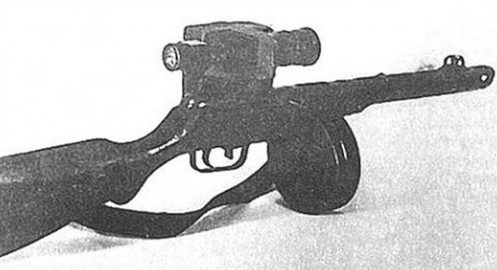
What a thermal imager can do
Any physical body with a temperature above absolute zero emits heat and can be detected with a modern thermal imager, regardless of inclement weather and poor lighting. It measures the temperature remotely. No one will hide from him with a protective suit or thickets of bushes.
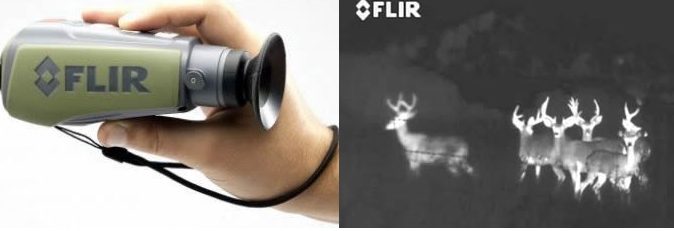
The device will help to detect a person in a smoky room, a fresh trace of an animal that has residual heat, hidden electrical wiring or a water heating pipe walled up in a reinforced concrete structure.

Already for the listed possibilities, and this is not a complete list, we can say that such products are equally suitable for the needs of the Ministry of Emergency Situations, hunters and builders.

We are not talking about the military, everything is clear here. We are dealing with unique optoelectronic equipment, which not only determines the temperature remotely, but allows you to select zones of different temperatures and build a heat map of the object (thermogram).
Principle of operation and device
A night vision device captures light reflected from an object of observation. In contrast, a thermal imager captures the temperature of the background and the actual object of observation, and highlights them in different colors (the warmer, the brighter). Unlike night vision devices, it cannot be blinded. It will work equally well in complete darkness and bright sunlight.
Its construction consists of:
- lens;
- IR receiver or matrix;
- display;
- control electronics;
- data warehouse.
With the help of a lens, the radiation is focused on the matrix, processed by electronics and displayed as an image, allowing the operator to identify objects by visible contours and glow intensity.
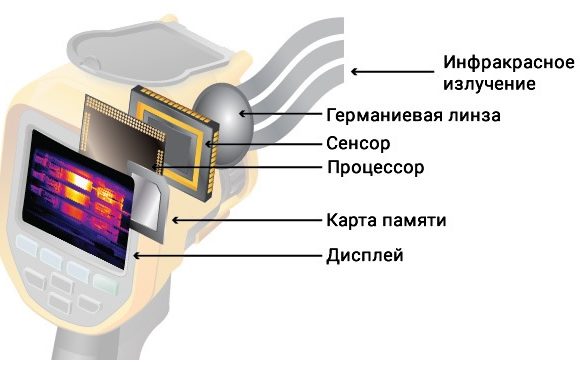 Each element performs certain functions that determine its type, technical capabilities and, ultimately, its scope. Therefore, it is worth getting to know each device separately.
Each element performs certain functions that determine its type, technical capabilities and, ultimately, its scope. Therefore, it is worth getting to know each device separately.
Matrix
It is called a sensor, detector, IR receiver. The matrix is the main part of the product. Its task is to receive thermal radiation with its subsequent transformation into electrical signals. Like a digital matrix, it consists of points called pixels. At the beginning of our story, we got acquainted with the invention of Samuel Pierpont Langley, called the bolometer.
On a note! Each pixel of the thermal imager matrix, and there can be from 20,000 to 1,000,000 of them, is a microbolometer made of amorphous silicon or vanadium oxide.
Depending on the application, the matrices have different sensitivity, observation range and resolution.
The matrices of stationary vehicles with increased sensitivity and observation range of about 10 km are capable of overheating. To avoid premature failure, they are made refrigerated. The detectors of portable and miniature devices do not need cooling. However, in terms of sensitivity, range. and other parameters, they are significantly inferior to stationary ones.
Lens specifications
Since quartz glass does not allow sunlight to pass through, the lenses are equipped with germanium lenses. The main characteristics of this element are its diameter, relative aperture (F), and light transmittance in the infrared range. The value of thermal sensitivity and image clarity directly depend on this. Portable products are most often equipped with lenses with diameters of 30.40 and 50 mm and further - 75 and 100 mm. As for the F number, the clearest images are given by lenses with F in the range from 1.0 to 1.2 units.

Display Features
A small screen for observing the contour and temperature of the object and background. The clarity of the picture increases with increasing screen resolution. The image is displayed in color or in black and white with 256 shades of gray. There are several display modes:
- full screen;
- increase;
- pictures;
- frame in frame.
The main types of thermal imagers
Devices are conventionally divided into two large classes. Let's tell them in more detail.
Observational
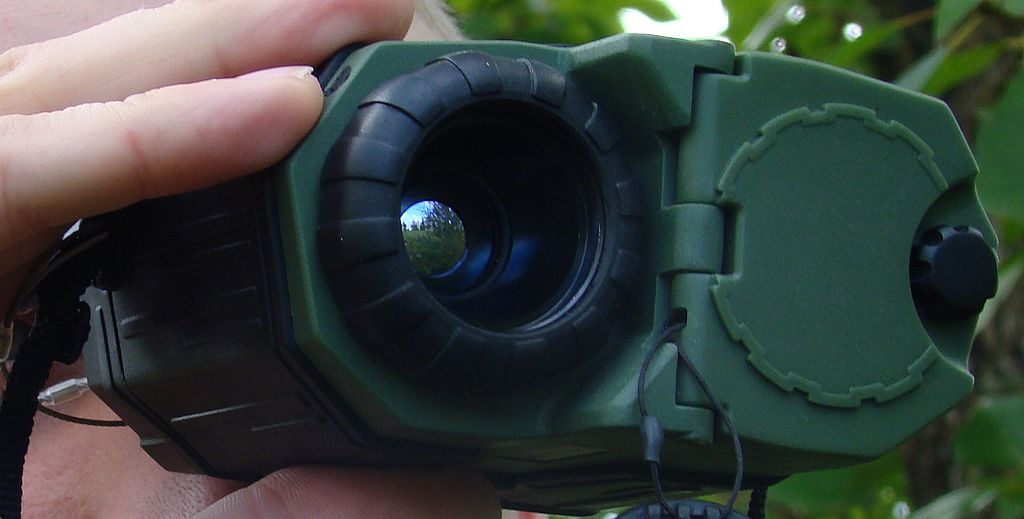
Portable and stationary. They are used as search, security, for construction, military purposes and for hunting, as night sights. The temperature of the object surface is determined by receiving and converting its thermal radiation, and then, using color gradation, the image is displayed on the display screen.They can be equipped with lenses of different diameters and can be combined with a laser rangefinder to determine the distance to an object. They work on targets remote up to 3000 m.
Measuring
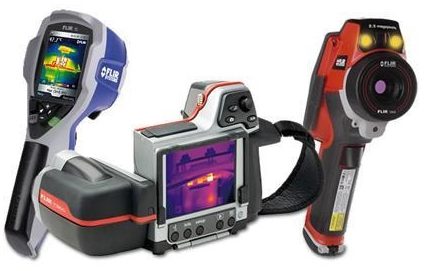
Products for special applications. They not only show the temperature difference between the object and the background, but are able to measure the temperature of the investigated surface. Equipped with calibrated matrices and software. The user can adjust and change parameters depending on changes in shooting conditions (air temperature, humidity, etc.).
They are used for medical and technical diagnostics, determination of heat leaks during energy audit of buildings and facilities, analysis of technological processes.
What are the measuring thermal imagers
Manual cameras
They do not differ in appearance from cameras or camcorders. Equipped with color displays, push-button control and several measurement modes. Available with the function of setting the time and date of shooting, built-in memory. In addition, the device can work with a removable flash card and is equipped with a USB connector for data transfer to a PC. Batteries or rechargeable batteries allow autonomous operation for a long time.
Stationary stations
Used in process monitoring systems. They are often integrated into various video surveillance systems. Capable of digital video recording and remote control.
Mobile devices
They can be made as attachments to a smartphone or as a normal mobile device (Seek products). Some models, such as the Flir One Pro, have two cameras, thermal and visible range. Mobile thermal imagers are very convenient for repairing faulty electrical wiring, in everyday life for detecting heat loss during the installation of window and door fillings in the places where joints are sealed with foam, etc. They are able to show a temperature difference of even two degrees. The set-top box connects to a smartphone via a charging port and can be self-powered.
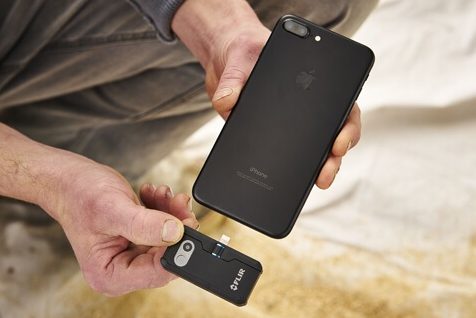 The original mobile version of the thermal imager in the form of an overlay for a smartphone. This, for example, is the FLIR ONE. The device consists of two overlays that you need to alternately put on the back of the iPhone. The one that is put on first plays the role of protection, the second one turns your gadget into a thermal imager. The product, equipped with thermal and conventional cameras, is activated by a slide switch.
The original mobile version of the thermal imager in the form of an overlay for a smartphone. This, for example, is the FLIR ONE. The device consists of two overlays that you need to alternately put on the back of the iPhone. The one that is put on first plays the role of protection, the second one turns your gadget into a thermal imager. The product, equipped with thermal and conventional cameras, is activated by a slide switch.

Pyrometers and multimeters with a thermal imager function are very convenient. An electrician can quickly find a faulty section of an electrical circuit by identifying an overheated area.
Thermal imager selection criteria
Detector resolution
This parameter of infrared cameras is inferior to the capabilities of conventional devices that shoot in the visible range. Therefore, to get a clearer picture, you should choose a device with a higher resolution. For a household device, a resolution of 160x120 pixels will be enough to find cold bridges in the structures of your home and take appropriate measures to eliminate them.
Semi-professional devices are equipped with a matrix with a resolution of 320x240 pixels. With them, you can do a professional energy audit and get decent quality thermograms.
In professional equipment, the matrix resolution can reach 640x480 or more pixels. These are very expensive products that can be used to generate official reports for supervisory organizations. There is no point in purchasing them for everyday or home use.
Measured temperature range
It is this parameter that determines the scope of the apparatus. To determine heat loss through building structures, it is sufficient that the device distinguishes between temperatures ranging from -20 to + 300 ° C. For the study of high-temperature production processes, devices that determine temperatures up to + 500 ° C are more suitable
Measurement error level
High measurement accuracy is required of models used in manufacturing for equipment test reports or process analysis. For most products, this parameter is +/- 2 ° C.
Near focus
This is the name of the minimum focusing distance or the smallest distance from the object to the surface of the matrix, at which you can get a clearly outlined image. For high-quality lenses, this parameter does not exceed 10 cm. Mobile models with conventional lenses can give a fairly clear picture from a distance of 30 cm.
Settings and correction
To improve the accuracy of the survey results, the measuring thermal imagers provide the ability to adjust the emissivity of the surface depending on its texture, as well as change the coefficient of the reflected temperature. Some corrections make it possible to take into account changes in shooting conditions and distance of the object. Finished results (thermograms) are saved as files on their own memory card and can be transferred to another device (PC) using the USB port. Each manufacturer developing software can provide for its own file format, which may not be opened when loaded onto the resources of other brands.
Optional equipment
When reporting to customers or supervisors, infrared images are sometimes not enough. For a more accurate reference of an object to the terrain and to determine the influence of nearby objects on its thermal characteristics, it is not bad to support the thermograms with images in the visible spectrum. To do this, it is better to use a thermal imager with a built-in digital camera.
In dimly lit places, the quality of shooting decreases dramatically. But with built-in LED lighting, this problem can be easily eliminated. In addition, the backlight can also work as a photo flash.
The built-in laser designator completes the overview of the thermal imager's optional equipment. With its help, you can select the area we need or a hazardous production facility in the image, which is better not to approach. It is easier to navigate and find the desired object in the infrared image using a laser marker on a digital photo.
What else should you pay attention to
With Wi-Fi support, you can connect the thermal imager to mobile gadgets or import thermograms onto them. If the audit works over a wide area, specialists can exchange images without delay, and this is a solid time saving.
Ergonomics or ease of use, especially for professionals, plays an important role. The device should have a comfortable grip and be light enough. Otherwise, the "pleasure" of using it can negatively affect the results of work. In addition, an unsuccessful interface, inconvenient arrangement of control buttons, a large number of menus and submenus complicate operation and irritate the operator.
Top manufacturers
- Fortuna
Russian brand. On the market since 2010. Specialization - search thermal imaging equipment for the Ministry of Emergencies, the army, hunting. The popularity of its models is explained by the use of innovative technical solutions and their high functionality.
- Condtrol
Russian manufacturer of non-destructive testing devices. The company sold its developments to well-known manufacturers: Trible, Laserliner, Ryobi. Since 2007, it has been producing inexpensive models using quality components from the world's leading manufacturers.
- Elitech
Russian brand. Factories in China, Republic of Belarus. Units and components are manufactured in factories in Italy. Thanks to such a wide geography of production units, the company manages budget and high-quality devices.
- Pulsssar
Belarusian division of the American company Ykon Advanced Optics. On the market since 2006. The main areas of work are products for hunters, search engines, rescuers, tourists and security systems. Popular models of her Pulsssar Thermion thermal imaging scopes are in high demand
- Flir
The largest manufacturer of thermal imagers from the USA. On the market for over 40 years. Factories in Europe, headquarters in Portland. It produces devices for the non-contact examination of objects of any format and purpose in a huge range.
- ANT
An American company specializing in the production of observation devices, sights, laser rangefinders.
- Fluke
Another major American manufacturer, the world leader in the production of instrumentation. Headquartered in Everett, with factories in the US, Europe and Asia. Professionals use the Fluke Ti, TiS and TiR Series models extensively for energy audits in the construction industry. The company's devices are distinguished by sharpness, automatic focusing, high-resolution matrices.
- Testo
The German company has been producing instrumentation for over 50 years. Produces equipment for household and professional use. Most of its devices are present in the State Register of Measuring Instruments of the Russian Federation and perform the tasks of industrial, technical and construction energy audits.
- Seek Thermal
An American private company based in Santa Barbara. Her specialization is consumer goods of good quality with wide functionality and at an affordable price.
The list of worthy manufacturers can be continued. It is up to you which company to buy the device. First, you should read the description of the product, find out how much the model you are interested in costs, listen to the advice and recommendations of experienced users
Rating of quality thermal imagers for repair
10. Elitech P 1000 TV

Thermal imager from a well-known Russian brand. Operates in the temperature range from -50 to + 200 ° C. The device has a memory card, functions of fixing values and automatic shutdown, a laser sight. The operator has the option of choosing a measurement scale (Celsius or Fahrenheit). Powered by 18650 Li-ion battery, with automatic shutdown to save power. The average price of the product is 20,010 rubles.
Advantages:
- compact size and light weight, 220 grams;
- fast response (0.25 sec);
- the ability to choose a color palette;
- emissivity correction function;
- the presence of LED backlight;
- the ability to save information on an additional memory card FAT 32.
Disadvantages:
- small size LCD monitor (2.4 inches);
- measurement error +/- 3%.
9. Condtrol IR – CAM 1

The minimum determined temperature is -50 ° C, the maximum is + 1000 ° C. Equipped with two cameras, conventional and infrared, which allows you to get a thermal image superimposed on a conventional digital image. Object temperature values appear after touching the display. Thermal emissivity correction can be made during measurement. Thermograms are saved in GPEG format. The device has a built-in memory of 1.0 gigabytes. In addition, the device is equipped with a slot for a removable memory card. Device management is simple and straightforward. To take a measurement, just press a button on the handle. Powered by built-in battery. The delivery set includes a plastic case for storing and carrying the device. Average price: 20992 rubles.
Advantages:
- high temperature range;
- two cameras: simple and infrared;
- touch screen;
- adjustable thermal emissivity;
- powerful built-in battery;
- built-in memory of 1 GB.
Disadvantages:
- not identified.
8. Flir One Pro LT

A unique mobile device, slightly larger than a lighter, is an attachment for an Android smartphone. Flir One Pro LT connects to the gadget via its USB charging port. Despite its small size, the device is equipped with two cameras and is a combination of a temperature sensor operating in the range from -20 to + 120 ° С, and powerful measuring instruments. Thanks to the updated Flir One app, the device can measure the temperature of multiple points or areas and transmit the results to the SmartWatch. Equipped with a matrix with a resolution of 80x60 pixels.
Flir MSX technology combines infrared and visible light images with HD camera resolution to make it clearer and more intelligible. The device is excellent at locating heat leaks through building structures or thermal insulation of pipelines and generating reports using the Flir Tools application. The average cost of the device is 25,580 rubles.
Advantages:
- compactness;
- extensive functionality in the Flir One application;
- work from remote access with the Flir Tools application;
- high image quality;
- two cameras.
Disadvantages:
- not identified.
7.CEM DT - 9868
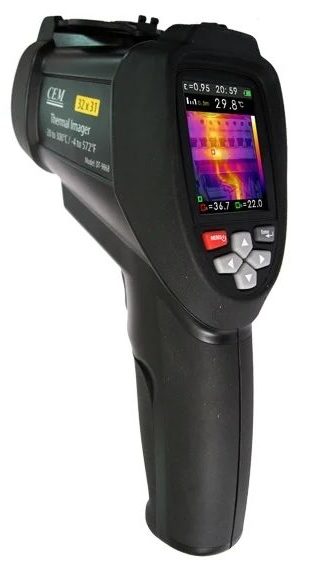
Thermal imager from a well-known Chinese manufacturer. With it, it is convenient to monitor the operation of equipment for the determination of overheating elements: switchboards, heating radiators, etc. The matrix with a resolution of 32x32 pixels operates in the range from -20 to + 300 ° С. The case is equipped with a slot for a memory card and a USB port for transferring data to a PC. The measurement results are saved in JPEG format. The average cost of the device is 27,639 rubles.
Advantages:
- high-quality assembly;
- two cameras;
- measurement accuracy +/- 2%;
- completed with a plastic case, a mini tripod.
Disadvantages:
- low matrix resolution;
- reset user settings when disconnected.
6. Seek Thermal Reveal

Compact monoblock thermal imager from the American company Seek Thermal. In addition to the LED camera, the device is equipped with an LED flashlight with two brightness modes with a power button separate from the device itself. The angle of view of the lens of the Reveal model is 36 °, the matrix resolution is 206x156 pixels. Temperature range from -40 to + 330 ° С.
The device is able to detect and measure the temperature of an object at a distance of up to 150m. The sealed housing protects against the ingress of dust and moisture. It can be used as a building and household. According to buyers, Seek Thermal Reveal has an excellent price-performance ratio.
Advantages:
- dust and moisture proof housing;
- high matrix resolution;
- optimal temperature range;
- the measurement range corresponds to the purpose of the device - to determine the places of heat leaks in building structures, damage to the insulation of pipelines, etc.
Disadvantages:
- not identified.
5.RGK TL - 70

Russian brand RGK. Presented in our review by the TL - 70 model, it easily determines heat leaks through structures and thermal insulation, finds overheated areas in electrical circuits. The infrared image is formed on a matrix with a resolution of 80x80 pixels and displayed on a 2.8-inch LCD display. The device automatically detects the temperature in the center of the image and calculates its maximum and minimum values over the entire observation field. In low light, you can use the built-in LED flashlight. The device operates in two temperature ranges:
- from -20 to + 150 ° С;
- from 0 to + 300 ° С.
The measurement error does not exceed 2%. Data transfer to a PC is carried out with a cable (supplied) via a USB port. Powered by a lithium battery, when fully charged, it lasts for 4 hours. To save energy, an automatic shutdown mode is provided. The average cost of the model is 54,900 rubles.
Advantages:
- operating time with a fully charged battery;
- clean and clear picture;
- ergonomic body;
- the ability to mount on a tripod;
- wide temperature range.
Disadvantages:
- high price.
4. Testo 865
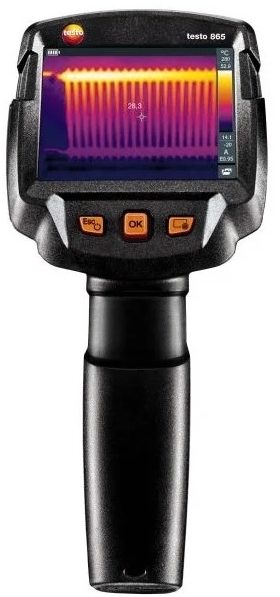
A product of a well-known German company specializing in the production of non-destructive testing devices. Model 865 is a professional device for determining heat loss and overheating, entered in the State Register of Measuring Instruments of the Russian Federation. It is widely used in power engineering. Operates in the temperature range from -20 to + 280 ° C with an error of no more than 2%. The matrix resolution is 160x120 pixels, you can increase using the SuperResoiution function up to 320x240 pixels and get a detailed and clear IR image of the object on the screen.
The operator can use the ScaleAssist function to filter temperature extremes and obtain a more accurate thermogram. According to customers, the professional Testo 865 is an example of the ideal balance between price, quality and functionality. Its purchase will cost the buyer 75,000 rubles. This is its average price.
Advantages:
- high definition of the image;
- width of the viewing angle 31 ° х23 ° allows you to shoot large objects in confined spaces;
- the presence of a fixed focus;
- automatic fixation of cold and hot spots;
- proprietary software for infrared image analysis.
Disadvantages:
- high price.
3. Bosch GTC 400C
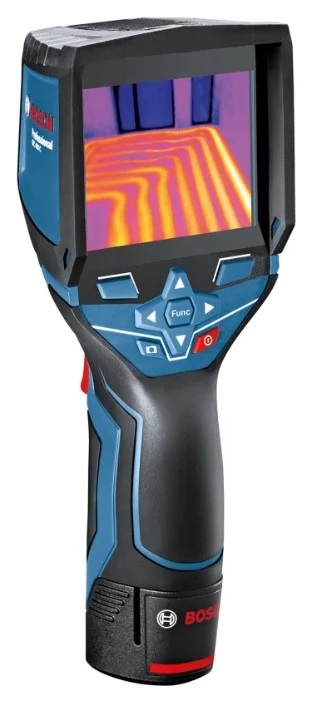
The best customer reviews are received by the Bosch GTS 400C model, designed to determine heat loss, diagnose warm floors and hidden wiring. Temperature range from -1 to + 400 ° С. Color display 3.5-inch. Matrix size 160x120 pixels. The controls are simple and straightforward. In the center of the panel is a selection button and four cursor buttons. The device has four operating modes:
- search for heat;
- search for cold;
- auto mode;
- manual mode with the possibility of various settings.
In the settings, you can select the material of the object under study, adjust the emissivity depending on the selected material. Available on and off indication of cold and hot spot, color scale (displayed on the right side of the screen), Wi-Fi. Additionally, you can select a language, set the date and time of shooting, enable or disable sound signals and set the time interval for automatic shutdown. Average price: 80,690 rubles.
Advantages:
- high-quality assembly;
- clear picture;
- powered by built-in accumulator and batteries;
- optimal set of operating modes;
- wide functionality.
Disadvantages:
- high price.
2. Fluk Tis 40

The device from the largest American manufacturer is equipped with a PIP (picture in picture) function with five presets, a built-in digital camera with a resolution of 5.0 megapixels and a wide field of view (35.7 ° x26.8 °). The size of the infrared matrix is 160x120 pixels. The temperature range for IR shooting is from -20 to +350 ° С. Built-in 4GB memory allows you to store a huge amount of images. Additionally, you can install a removable memory card for another 4 GB. The LCD is large enough (3.5 inches diagonal). Average price: 184,885 rubles.
Advantages:
- ergonomics;
- build quality;
- clear picture;
- Ease of controls;
- wide functionality.
Disadvantages:
- high price.
1. Fluke Tis 55

As in the previous version, the device is equipped with the PIP function with the same number of presets and a 5-megapixel digital camera. The thermal range is extended from -20 ° С to + 450 ° С. The resolution of the IR detector has also been increased to 260x160 pixels. The amount of information stored: 4 GB each on the built-in memory and a removable card. Images can be annotated with IR-PhotoNotesTM, or using voice annotation. Average cost: 366 530 rubles.
Advantages:
- ergonomics;
- build quality;
- super clear picture;
- simple point-and-click control;
- extended functionality.
Disadvantages:
- very high price.
The purchase of even a simple thermal imager is associated with serious costs. In order not to make mistakes when choosing and not to waste money, you should study the capabilities of the device, compare them with your needs, and determine the best manufacturer for yourself. We hope that our review will tell you how to choose the right model of a thermal imager for a home, energy audit, electrical repair, diagnostics of hidden heating pipelines and professional energy audit.












